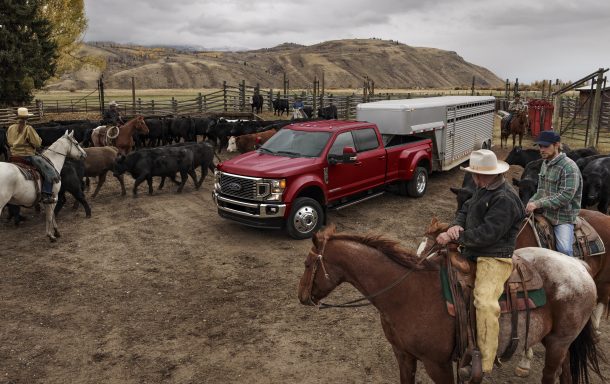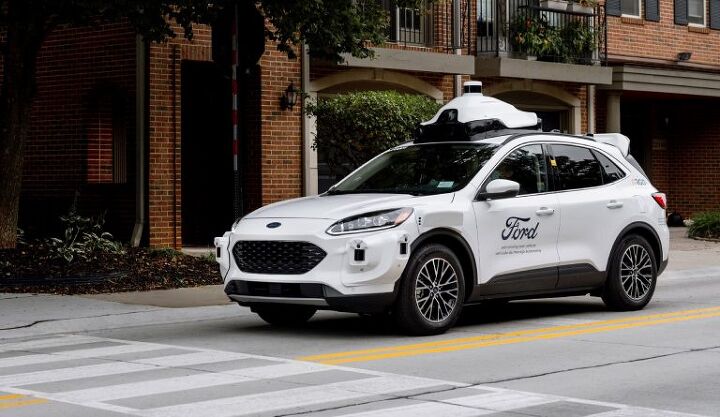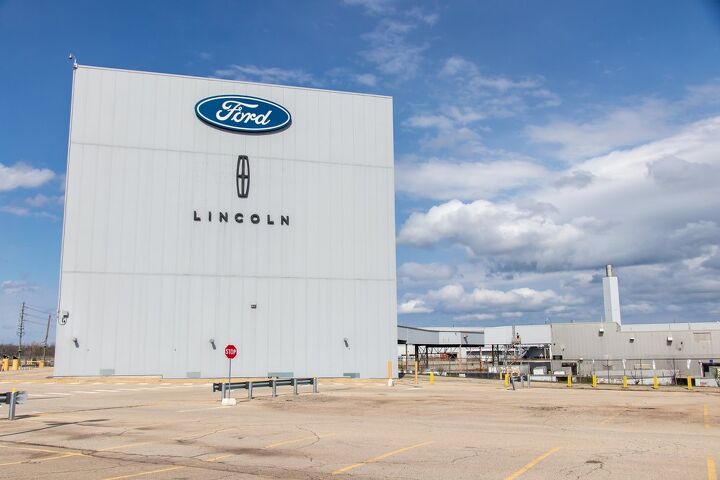#FordMotorCo
Ford Says Electric Super Duty Trucks Aren't Happening
While Ford’s F-150 is slated for electrification, Super Duty versions of the F-Series are not. On Monday, the automaker told industry analysts that HD EVs weren’t in the cards — adding that customers can still expect all-electric versions of the Mach-E “Mustang” and Transit van.
“Our goal is to build a profitable electric vehicle portfolio,” John Lawler, Ford chief financial officer, explained during the forum hosted by Dan Levy of Credit Suisse. “To do that, we need to leverage our strengths and the scale that we have. We’re being very strategic about the platforms that we choose.”
Ford Says Electric Transit Vans Are Coming for Real This Time
Eager to prove itself as a forward thinking mobility brand, Ford has advised us to prepare for the debut of the battery powered E-Transit van on November 12th. Following some heavy teasing from CEO Jim Farley during the company’s third-quarter earnings call a day earlier, Blue Oval issued an official announcement on Thursday to be ready for the commercial vehicle poised to change the way it does vans.
We’ve heard this before. There was supposed to be a battery electric Transit Connect, developed in partnership with Azure Dynamics, coming to market for the 2011 model year. While a prototype existed and was driven around by numerous outlets who praised it for being incredibly normal, the car ended up being prohibitively expensive to manufacture and kind of underwhelming to live with. Range was an abysmal 56 miles (according to the EPA) and the van was only just barely capable of maintaining highway speeds. In the end, Ford handed the project over to Azure — which nixed the passenger model and sold a few thousand commercial versions to various U.S. bureaucracies, coastal power companies, AT&T and the Canada Post for a little under $60,000 a pop.
Ford Adding Big Boy Touchscreen to 2021 Edge
Despite rumors that the current-generation Ford Edge will be the company’s last, Blue Oval has decided to give the crossover a 12-inch touchscreen as standard equipment for 2021. You probably didn’t ask for it, you definitely don’t need it, and it will likely increase the chances of a horrific accident when someone has to take their eyes off the road to use it. But it’s coming and will be the largest-in-class center stack screen going into production, trumping the optional 10.1-inch unit that’s available on the larger Ford Explorer.
Fortunately, it doesn’t seem to take up much more real estate, as the automaker has chosen to install it portrait style. But it does appear to be supplanting psychical climate controls while leaving knobs for the volume and radio turning/track selection. Other updates to the 2021 Edge include fresh wheel designs, additional interior trim choices, and a couple of new exterior colors — both of which happen to be shades of gray.
Ford's Autonomous Offensive Places Escape Hybrid on the Front Line
With Ford having discontinued the Fusion sedan to prioritize higher-margin models, the automaker will need to select a different unit as its preferred platform for self-driving test mules. It will need to choose wisely, too. According to the company, its fourth of generation autonomous test vehicles will foreshadow real-world commercial endeavors using the technology.
On Tuesday, Ford and Argo AI announced that it would be the Escape Hybrid carrying the torch of technology. Starting this month, models fresh from the factory will be modified with the “latest advancements in sensing and computing technology.” The crossover will then be exposed to the most rigorous testing regimen the automaker’s ongoing AV program can muster. From there, the Escape will serve as the architecture and platform Ford has decided will bring its autonomous vehicle service to life.
Facing Emission Fines, Ford Becomes Ravenous for Carbon Credits
Ford is joining the lengthening list of automakers that cannot adhere to European emissions mandates this year and is pursuing the popular option of simply buying carbon credits from rivals who managed to sell more than a few electrified vehicles.
Under the EU rules, manufacturers can “earn” carbon credits by selling more EVs. But legacy automakers were hamstrung all year by the pandemic and Ford is on the hook for a recall of its Kuga (Escape) PHEV. The Blue Oval recalled almost 21,000 examples of the plug-in hybrid in August, asking owners not to drive the crossover in its electric-only mode and to avoid charging the battery. While alarming in its own right, Ford said the recall effectively makes it impossible for it to meet 2020 EU emission quotas. It is now seeking partners for an “open emissions pool” and is hardly the only manufacturer doing this.
2021 Ford Transit Designed for Business AND Pleasure
While van sales have been trending downward for years, the likelihood of your average American being forced to live inside one feels like it should be higher than ever. But deciding which model is best for living out the rest of your days in relative isolation isn’t going to be easy. Realizing that there’s a growing demand for escape vehicles and regular old RVs, automakers and coachbuilders have been trying to make the market more accommodating.
On Tuesday, Ford Motor Co. threw its hat into the ring by announcing that the 2021 Transit would be adding new “recreational and business options” to help get customers the kind of vehicles they need to get through these difficult times.
“With many Americans working from home and practicing social distancing during the pandemic, the popularity of recreational vehicles has soared at the same time package delivery has seen incredible growth,” explained Tiffany Chang, Ford fleet brand strategy manager. “Our new 2021 Transit options help people design the recreational vehicles of their dreams and help enable our commercial customers to more efficiently deliver goods and services across the country.”
2021 Ford Mustang Mach 1 Pricing Announced, Could Have Been Worse
Enthusiasts are up in arms about the departing Ford Mustang Shelby GT350 because they already know its Mach 1 replacement won’t be able to compete with it on a racetrack. This was by design, however. Ford wants something a little more street friendly and easier on people’s wallets. It can also save on production costs by utilizing components that helped make the GT350 an engineering marvel, without relying on its pricey V8 with the flat-plane crankshaft. The Mach 1 gets the same 5.0-liter V8 found inside GT models, tweaked to deliver 480 hp and 420 pound-feet of torque.
On the 73rd anniversary of Chuck Yeager breaking the sound barrier (aka Mach 1) in the Bell X-1 “Glamorous Glennis,” Ford decided to tell us how much the upcoming model will cost so it could begin taking orders. The automaker has settled on $52,915 (including destination), placing the Mach 1 a healthy $4,000 above the Bullitt Mustang and nearly ten grand below the outgoing GT350.
Salaried Ford Employees to Work Remotely Through June
With so many individuals still working remotely to combat The Dreaded Coronavirus™ from spreading, there have to be thousands of pools on when employees will finally be allowed to return to their cobweb-filled offices. But they have to be getting pretty boring because its hard to imagine anybody confidently putting their money down on late 2021 when this whole thing started in February and the press still thought it wouldn’t be a big deal. The narrative has definitely changed since then and continued social distancing has become a popular solution among businesses, even as state-sanctioned lockdown protocols decline after a few were ruled to be unconstitutional.
On Thursday, Ford decided to keep most of its salaried employees at home until at least June of 2021. That’s eight more months of not going into the office and matches the timetable General Motors issued a few weeks ago.
Canada Contributing $447 Million Toward Ford Plant Upgrades
With Ford and Unifor having agreed to a new three-year contract last month, Oakville Assembly (which currently manufacturers the Ford Edge and Lincoln Nautilus) is slated to be retooled to manufacturer electric vehicles and their batteries. While the first example wouldn’t roll off the assembly line until 2026, according to the agreement, Canada is excited about the prospect of green jobs. In fact, the Canadian government has committed itself to an ambitious program aimed at boosting electric vehicle sales in order to achieve net-zero carbon emissions by 2050.
We’re always suspect of central planning, as regulatory changes often have unintended consequences for the associated industries, but need to praise Canada for actually putting some money where its mouth is. Barring a mishap in 2023, the nation has promised to contribute $447 million (split evenly between the Ontario and federal governments) toward Ford’s 1.4-billion program to convert the facility.
Ford Ending Production of Mustang Shelby GT350/R
Even the most capable of race horses eventually reach that day where they’re taken out behind the stables to be shot or stabbed — whatever happens to them after they’ve passed their prime. The same is true in the automotive realm, with the only difference being that the cars are not eventually turned into food for my cat.
Ford has decided to end production of the track-focused Mustang Shelby GT350/R this year. Introduced in 2015, the model uses a 5.2-liter “Voodoo” V8 with a flat-plane crankshaft for some of the nicest naturally aspirated action money can buy. On the current model year (which will also be the last) 526 horsepower is sent through a Tremec six-speed, with performance further aided by a transmission cooler, limited slip rear axle, track-worthy suspension, upgraded Brembo brakes and super-sticky Michelin Pilot Sport Cup 2 rubber.
If you’re one of the few individuals who needs a good track-day vehicle, you could certainly do worse. And now you’ll have to because dealer orders already ended.
Ford Camera Recall Encompasses 700,000 in North America
Ford is recalling over 700,0000 vehicles in North America over poor electrical connections that can put the rearview camera display on the fritz. The feed runs the risk of providing drivers a corrupted image or cutting out intermittently, raising crash risks, and violating present-day vehicle safety mandates. While the tried and true method of turning one’s head and using the mirrors should allow for drama-free parking, Ford is still under obligation to repair these systems.
Documents submitted to the National Traffic Highway Safety Administration (NHTSA) have indicated that affected models include Ford’s Edge, Escape, Expedition, Explorer, F-150, F-250, F-350, F-450, F-550, Mustang, Ranger, and Transit vehicles from the 2020 model year. Lincoln will also be recalling the 2020 Lincoln Corsair and Nautilus.
Electric F-150 Will Be Far Cheaper to Own Than Gas Model, Claims Ford
Ford has really been hyping the upcoming F-Series EV this week by assuring customers the new pickup will make the gas-powered one look like the unsightly substance you cough into the sink every morning. Not only with the electrified F-150 come with more power than your standard Ford truck, but it’ll also be cheaper to own and operate — once you get past the higher purchasing price, of course.
The automaker is spending a whopping $700 million to add EV production facilities at the Dearborn Truck Plant on top of the lofty cost of development, so it’s going to tell you whatever it takes to get you to buy one. It has to recoup those expenses somehow and, unless it’s a bald-faced lie, the automotive industry always seems willing to be “extremely optimistic” about a vehicle prior to launch. Unfortunately, Ford has to remain slightly more grounded than some of its peers because the electric F-150 isn’t so completely novel that the manufacturer can claim it will totally transform the driving experience or makes ludicrous suggestions about it driving itself.
We already have an F-150 and people seem to think it’s good enough to warrant nearly a million sales per year. The electric version is a spin-off Ford wants us to understand builds on those strengths.
Ford to Cut 1,400 Salaried Positions in U.S. Through Buyout Initiative
Barely a full day after news broke that Ford was on the cusp of announcing layoffs, Ford announced those layoffs. On Wednesday, the automaker informed employees that it needs to eliminate 1,400 salaried jobs as part of its $11-billion restructuring program. The good news is that these cuts will be handled through retirement buyouts that won’t leave the departing workforce empty handed. The automaker’s internal memo also stated that the buyouts would be voluntary.
The Blue Oval previously said it expects a full-year loss in 2020 thanks to the pandemic, with a pre-tax profit of anywhere between $500 million and $1.5 billion in the third quarter.
Ford, BMW Planning Job Cuts In U.S.
With a large number of automakers pinching pennies these days, it’s easy for the details of various restructuring plans to fall down the memory hole. For example, Ford has been engaged in an ambitious cost-cutting program since 2018. The $11-billion plan was said to take anywhere from three to five years to complete, requiring legitimate sacrifices at the company — including the discontinuation of all sedans in the United States, ending operations in Russia, closing facilities in Europe, and rolling layoffs around the globe.
Ford has actually accelerated its timeline to see how much it can get done before 2021, resulting in the elimination of 7,000 salaried positions globally last year. The company has decided to end another 1,000 salaried positions in the United States.
Ford: Battery Plants Would Be Pointless Right Now
If electric vehicles are ever to supplant the tried-and-true gasoline-driven automobile, we’ll need to make a lot of changes. Infrastructure will need to tailor itself to electric driving by implementing more charging stations while bolstering the electrical grid with more power plants and a higher capacity for energy storage. But auto manufacturers will also need to manufacture them at a scale that will adequately feed society, requiring more capable machines — and the batteries they’ll be dependent upon.
While most large automakers have dumped billions into R&D for “mobility projects,” including items pertaining directly toward advancing EVs, their approaches have varied. Some manufacturers (e.g. Tesla) built battery plants to support themselves, others are contented with having made deals with suppliers. Ford has officially taken the latter approach, according to its own leadership.
























Recent Comments